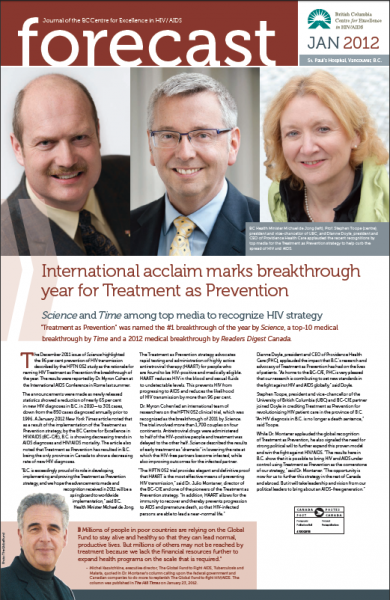International acclaim marks breakthrough year for Treatment as Prevention
Science and Time among top media to recognize HIV strategy
 “Treatment as Prevention” was named the #1 breakthrough of the year by Science, a top-10 medical breakthrough by Time and a 2012 medical breakthrough by Readers Digest Canada.
“Treatment as Prevention” was named the #1 breakthrough of the year by Science, a top-10 medical breakthrough by Time and a 2012 medical breakthrough by Readers Digest Canada.
The December 2011 issue of Science highlighted the 96 per cent prevention of HIV transmission described by the HPTN 052 as the rationale for naming HIV Treatment as Prevention the breakthrough of the year. The study results were reported by Dr. Myron Cohen at the International AIDS Conference in Rome last summer
The announcements were made as newly released statistics showed a reduction of nearly 65 per cent in new HIV diagnoses in B.C. in 2010—to 301 cases, down from the 850 cases diagnosed annually prior to 1996. A January 2012 New York Times article noted that as a result of the implementation of the Treatment as Prevention strategy, by the BC Centre for Excellence in HIV/AIDS (BC-CfE), B.C. is showing decreasing trends in AIDS diagnoses and HIV/AIDS mortality. The article also noted that Treatment as Prevention has resulted in B.C. being the only province in Canada to show a decreasing rate of new HIV diagnoses.
“B.C. is exceedingly proud of its role in developing, implementing and proving the Treatment as Prevention strategy, and we hope the advancements made and recognition received in 2011 will be a springboard to worldwide implementation,” said B.C. Health Minister Michael de Jong.
The Treatment as Prevention strategy advocates rapid testing and administration of highly active antiretroviral therapy (HAART) for people who are found to be HIV-positive and medically eligible. HAART reduces HIV in the blood and sexual fluids to undetectable levels. This prevents HIV from progressing to AIDS and reduces the likelihood of HIV transmission by more than 96 per cent.
Dr. Myron Cohen led an international team of researchers on the HPTN 052 clinical trial, which was recognized as the breakthrough of 2011 by Science. The trial involved more than 1,700 couples on four continents. Antiretroviral drugs were administered to half of the HIV-positive people and treatment was delayed to the other half. Science described the results of early treatment as “dramatic” in lowering the rate at which the HIV-free partners become infected, while also improving outcomes for the infected partner.
“The HPTN 052 trial provides elegant and definitive proof that HAART is the most effective means of preventing HIV transmission”, said Dr. Julio Montaner, director of the BC-CfE and one of the pioneers of the Treatment as Prevention strategy. “In addition, HAART allows for the immunity to recover and thereby prevents progression to AIDS and premature death, so that HIV-infected persons are able to lead a near-normal life.”
Dianne Doyle, president and CEO of Providence Health Care (PHC), applauded the impact that B.C.’s research and advocacy of Treatment as Prevention has had on the lives of patients. “As home to the BC-CfE, PHC is very pleased that our research is contributing to set new standards in the fight against HIV and AIDS globally,” said Doyle.
Stephen Toope, president and vice-chancellor of the University of British Columbia (UBC) and BC-CfE partner joined Doyle in crediting Treatment as Prevention for revolutionizing HIV patient care in the province of B.C. “An HIV diagnosis in B.C. is no longer a death sentence,” said Toope.
While Dr. Montaner applauded the global recognition of Treatment as Prevention, he also signaled the need for strong political will to further expand this proven model and win the fight against HIV/AIDS. “The results here in B.C. show that it is possible to bring HIV and AIDS under control using Treatment as Prevention as the cornerstone of our strategy,” said Dr. Montaner. “The opportunity is now for us to further this strategy in the rest of Canada and abroad. But it will take leadership and vision from our political leaders to bring about an AIDS-free generation.”
